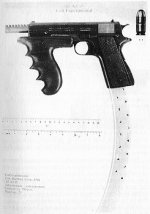what would make a 1911 run or seem to run fully auto (similar to the trigger speed assisted by a slide fire stock)?
The short answer is, A
MALFUNCTION.
Worn parts, broken parts, parts deliberately altered for a better "this or that" (trigger pull, usually)... EXTRA parts, aftermarket parts and their fitting, even dirt & crud, in the right amount in the right place. THESE are the factors that make a 1911 "run away".
While there was a select fire variant of the 1911 style (Star?) made in Spain at one time, it was neither popular nor effective. Standard handguns at 2.5-3lbs are simply to light for controllable full auto fire.
The world's fastest shooters can make a 1911 SOUND like a machinegun, but only when there is no machinegun present to compare it with. Note that the world speed records are held by gifted individuals shooting DA revolvers!
There is no "slidefire" or "bumpfire" device for the 1911 that I know of, and they would be a more than slightly stupid idea, to use, if someone did make one. Un & undertrained people cannot keep a Tommygun on target, and it weighs four times (or more) what a 1911 pistol does (and it has a lot more to hang on to!). What do you think the likely results of a full auto (or nearly full auto slilde fire speed) would be in the 1911 pistol?
As others have said, from seeing real world examples, most of the rounds go airborne! (over the target, over the berm, through the roof, etc)
The people that really scare me are the ones who tinker with the insides of the pistol to get a "good" trigger pull that they think they need. When you get the trigger pull down around the 3lb range (or less) you run serious risks of have the pistol "jar off" and go full auto. 3.5lbs seems to be possible and lasting, much less than that I think is a risk.
And, before someone writes in telling how they have a perfect 2.5, 2, 1.5lb, etc., trigger pull and have fired a quarter million rounds with zero malfunctions, I say Bully for you! Set up shop, and your fortune is made! Best be heavy on the liability insurance, though!





